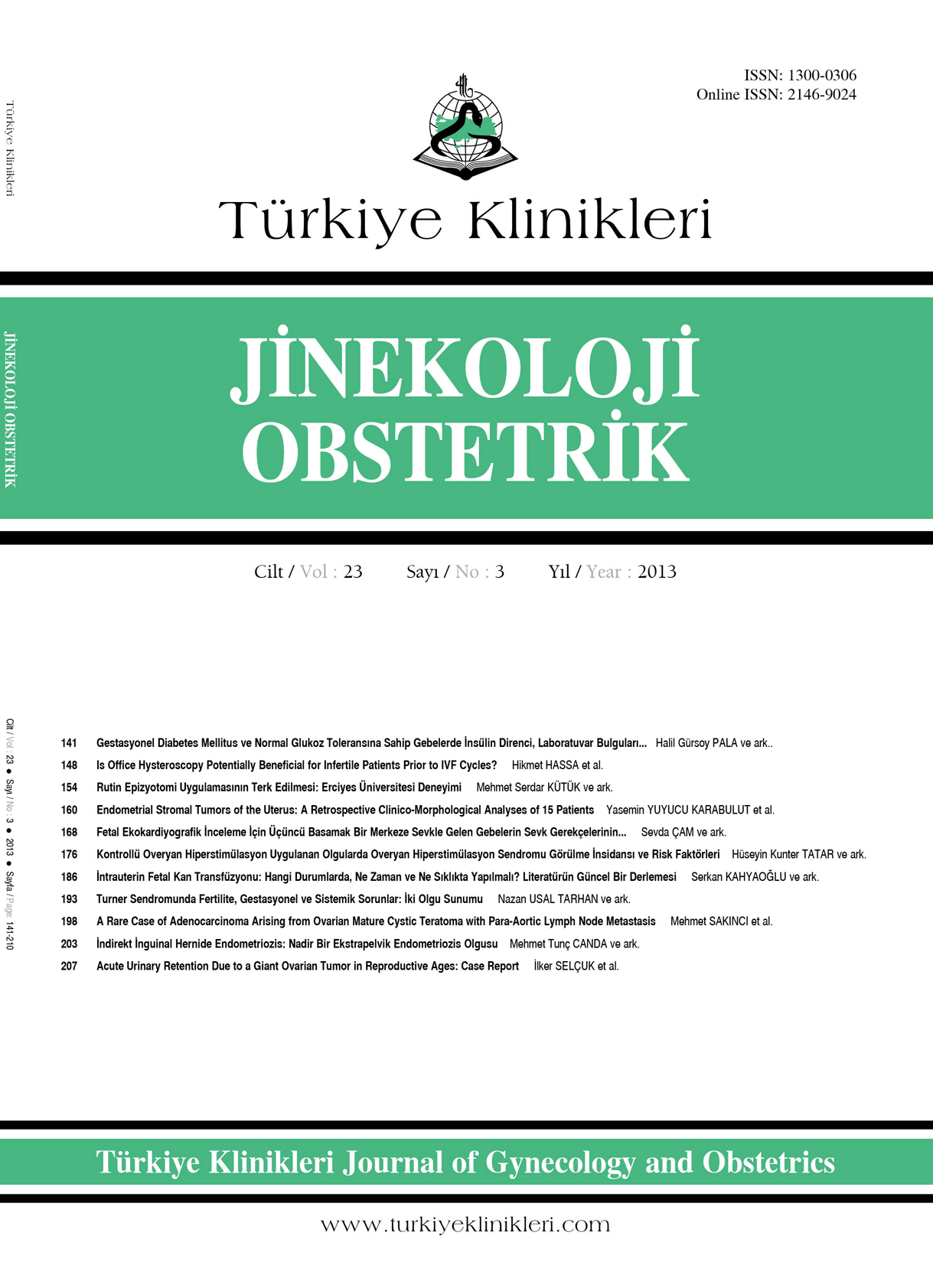Open Access
Peer Reviewed
ORIGINAL RESEARCH
4308 Viewed2507 Downloaded
Abondoning Routine Episiotomy Application: Erciyes University Experience
Rutin Epizyotomi Uygulamasının Terk Edilmesi: Erciyes Üniversitesi Deneyimi
Turkiye Klinikleri J Gynecol Obst. 2013;23(3):154-9
Article Language: TR
Copyright Ⓒ 2025 by Türkiye Klinikleri. This is an open access article under the CC BY-NC-ND license (http://creativecommons.org/licenses/by-nc-nd/4.0/)
ÖZET
Amaç: Bu çalışmanın amacı, rutin epizyotomiden sınırlı epizyotomi uygulamasına geçiş süreci ve her iki döneme ait sonuçların karşılaştırılmasıdır. Gereç ve Yöntemler: Erciyes Üniversitesi, Kadın Hastalıkları ve Doğum Anabilim Dalında, 1000 g üzerindeki canlı doğum yapan olgularda rutin (2011-2012 seneleri) ve sınırlı (2012-2013) epizyotomi uygulanan dönemlere ait veriler retrospektif olarak karşılaştırıldı. Bulgular: 2011-2012 yıllarında toplam 651 doğumda epizyotomi oranı %88,6 (577/651) olarak tespit edildi. Bu oran nulliparlarda %89,7 (270/301) ve multiparlarda %87,7 (307/350) idi. İki olguda 3. derece perine yırtığı saptandı (2/651, %0,3). 2012-2013 yılları arasında toplam 619 doğum gerçekleştirildi. Maternal yaş ve ortalama doğum ağırlığı multiparlarda anlamlı derecede yüksekti [30 (17-49 yıl) ve 23 (16-40 yıl) ve 3130 g (1000-4440 g) ve 2910g (1000-4400 g), p=0,007]. Genel epizyotomi oranı sınırlı epizyotomi grubunda %27,9 (173/619) iken, bu oran multiparlarda %6,8 (24/350), nulliparlarda %55,4 (149/269) olarak bulundu. Epizyotomi açılmayan grupta paraüretral birinci ve ikinci derece perine laserasyonu istatistiksel olarak anlamlı derecede daha sık görüldü (p<0,01). Sınırlı epizyotomi açılan 2012-2013 döneminde üçüncü ya da dördüncü derece perine laserasyonu izlenmedi. Doğumu yaptıran araştırma görevlileri arasında kıdem, cinsiyet gibi değişkenlerin epizyotomi açma oranını etkilemediği saptandı. Sonuç: Sınırlı epizyotomi uygulaması, rutin epizyotomi uygulaması ile karşılaştırılabilir perineal sonuçlara sahiptir. Benimsenecek basit prensipler ile kısa sürede rutin uygulamadan sınırlı uygulamaya geçilmesi ve epizyotomi oranının azaltılması mümkündür.
Amaç: Bu çalışmanın amacı, rutin epizyotomiden sınırlı epizyotomi uygulamasına geçiş süreci ve her iki döneme ait sonuçların karşılaştırılmasıdır. Gereç ve Yöntemler: Erciyes Üniversitesi, Kadın Hastalıkları ve Doğum Anabilim Dalında, 1000 g üzerindeki canlı doğum yapan olgularda rutin (2011-2012 seneleri) ve sınırlı (2012-2013) epizyotomi uygulanan dönemlere ait veriler retrospektif olarak karşılaştırıldı. Bulgular: 2011-2012 yıllarında toplam 651 doğumda epizyotomi oranı %88,6 (577/651) olarak tespit edildi. Bu oran nulliparlarda %89,7 (270/301) ve multiparlarda %87,7 (307/350) idi. İki olguda 3. derece perine yırtığı saptandı (2/651, %0,3). 2012-2013 yılları arasında toplam 619 doğum gerçekleştirildi. Maternal yaş ve ortalama doğum ağırlığı multiparlarda anlamlı derecede yüksekti [30 (17-49 yıl) ve 23 (16-40 yıl) ve 3130 g (1000-4440 g) ve 2910g (1000-4400 g), p=0,007]. Genel epizyotomi oranı sınırlı epizyotomi grubunda %27,9 (173/619) iken, bu oran multiparlarda %6,8 (24/350), nulliparlarda %55,4 (149/269) olarak bulundu. Epizyotomi açılmayan grupta paraüretral birinci ve ikinci derece perine laserasyonu istatistiksel olarak anlamlı derecede daha sık görüldü (p<0,01). Sınırlı epizyotomi açılan 2012-2013 döneminde üçüncü ya da dördüncü derece perine laserasyonu izlenmedi. Doğumu yaptıran araştırma görevlileri arasında kıdem, cinsiyet gibi değişkenlerin epizyotomi açma oranını etkilemediği saptandı. Sonuç: Sınırlı epizyotomi uygulaması, rutin epizyotomi uygulaması ile karşılaştırılabilir perineal sonuçlara sahiptir. Benimsenecek basit prensipler ile kısa sürede rutin uygulamadan sınırlı uygulamaya geçilmesi ve epizyotomi oranının azaltılması mümkündür.
ABSTRACT
Objective: The purpose of the study was to assess the process of transition from routine episiotomy to restrictive episiotomy and to compare the results of these different approaches. Material and Methods: Birth data of women delivering live-born infant weighting more than 1000 g in the period of routine episiotomy (2011-2012) and restrictive episiotomy (2012-2013) in Erciyes University, Department of Obstetrics and Gynecology were compared retrospectively. Results: In 651 birth, the episiotomy rate was 88.6% (577/651) between 2011-2012. This ratio was 87.7% (307/350) in multiparous, and 89.7% (270/301) in nulliparous. Two cases were complicated with third degree perineal laceration (2/651, %0.3). 619 vaginal delivery were performed between 2012-2013. The mean maternal age and birth weight were higher in multiparous women [30 (17-49 years) vs 23 (16-40 years) and 3130g (1000-4440 g) vs 2910g (1000-4400 g), p=0.007, respectively]. The episiotomy rate in general was 27.9% (173/619), and was 6.8% (24/350) in multiparous, and was 55.4% (149/269) in nulliparous. The prevalance of first degree, second degree and paraurethral laceration were higher in non- episiotomy group (p<0.01). No cases of third, or fourth degree perineal laceration was seen between 2012 and 2013 during which restrictive episiotomy was performed. There was no statistically significant relationship between the experience, and gender of the residents, and episiotomy ratio. Conclusion: Restrictive episiotomy application has comparable perineal complication ratio to that of routine episitomy. It is possible to switch from routine episiotomy to restrictive episiotomy, and to decrease episiotomy ratio by the application of certain simple principles.
Objective: The purpose of the study was to assess the process of transition from routine episiotomy to restrictive episiotomy and to compare the results of these different approaches. Material and Methods: Birth data of women delivering live-born infant weighting more than 1000 g in the period of routine episiotomy (2011-2012) and restrictive episiotomy (2012-2013) in Erciyes University, Department of Obstetrics and Gynecology were compared retrospectively. Results: In 651 birth, the episiotomy rate was 88.6% (577/651) between 2011-2012. This ratio was 87.7% (307/350) in multiparous, and 89.7% (270/301) in nulliparous. Two cases were complicated with third degree perineal laceration (2/651, %0.3). 619 vaginal delivery were performed between 2012-2013. The mean maternal age and birth weight were higher in multiparous women [30 (17-49 years) vs 23 (16-40 years) and 3130g (1000-4440 g) vs 2910g (1000-4400 g), p=0.007, respectively]. The episiotomy rate in general was 27.9% (173/619), and was 6.8% (24/350) in multiparous, and was 55.4% (149/269) in nulliparous. The prevalance of first degree, second degree and paraurethral laceration were higher in non- episiotomy group (p<0.01). No cases of third, or fourth degree perineal laceration was seen between 2012 and 2013 during which restrictive episiotomy was performed. There was no statistically significant relationship between the experience, and gender of the residents, and episiotomy ratio. Conclusion: Restrictive episiotomy application has comparable perineal complication ratio to that of routine episitomy. It is possible to switch from routine episiotomy to restrictive episiotomy, and to decrease episiotomy ratio by the application of certain simple principles.
MENU
POPULAR ARTICLES
MOST DOWNLOADED ARTICLES





This journal is licensed under a Creative Commons Attribution-NonCommercial-NoDerivatives 4.0 International License.










